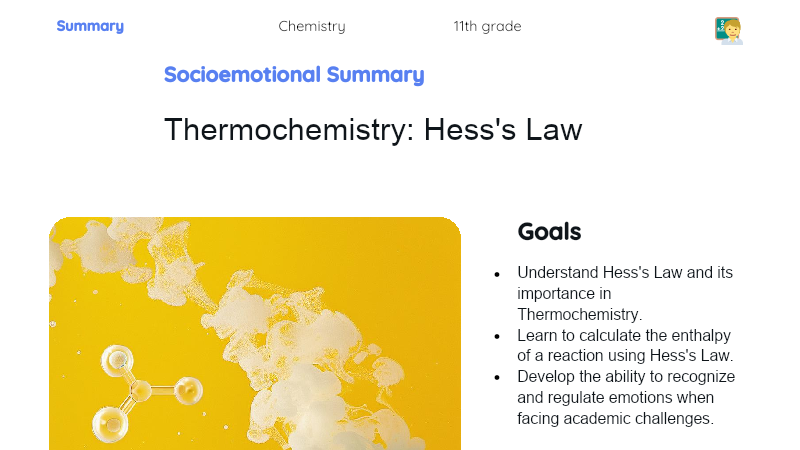Introduction
Relevance of the Topic
Mole: Amount of Substance is a crucial concept in Chemistry. The mole bridges the gap between the microscopic and macroscopic scale, facilitating the visualization and understanding of the quantity of atoms, molecules, or ions present in a substance. Understanding the concept of mole is essential to comprehend more advanced topics, such as calculating chemical reactions, stoichiometry, reaction energy, and physical chemistry in general.
Contextualization
The concept of mole is a key element in organizing the Chemistry discipline, being one of the first topics addressed in High School. It not only provides a solid foundation for developing mathematical skills in Chemistry but also serves as an introduction to atomic theory and ways to quantify matter.
Furthermore, the concept of mole is intrinsically linked to Avogadro's number, a fundamental constant in Chemistry, and to molar mass, which is the 'weight' of one mole of a substance. This knowledge allows the resolution of a wide variety of problems in Chemistry, from calculating mass and volume to determining percentage compositions and interpreting chemical equations.
Therefore, understanding the concept of mole and its practical application is necessary for progress in the field of Chemistry and the ability to solve chemical problems.
Theoretical Development
Components
-
What is a Mole?: A mole is a unit of measurement that represents the quantity of substance. Quantitatively, one mole of any substance contains the same number of particles (atoms, molecules, ions) as there are in 12 grams of carbon-12.
-
Avogadro's Number: Avogadro's number (6.022 x 10^23) is the number of elementary entities contained in one mole of any substance.
-
Molar Mass: Molar mass is the mass of one mole of a substance. It is expressed in grams/mole (g/mol). The molar mass is numerically equal to the atomic or molecular mass of a substance, expressed in atomic mass units (u).
-
Molarity: Molarity (M) is a concentration measurement that expresses the number of moles of a solute per liter of solution. Molarity (M) = n/V, where n is the number of moles of solute and V is the volume of the solution in liters.
Key Terms
-
Mole: Unit of measurement representing the quantity of a substance.
-
Avogadro's Number: Number of particles (atoms, molecules, ions) in one mole of any substance.
-
Molar Mass: Mass of one mole of a substance, expressed in grams. It is numerically equal to the atomic or molecular mass.
-
Molarity: Concentration of a solution, expressed as the number of moles of solute per liter of solution.
Examples and Cases
-
Calculating Moles: From a sample, regardless of the substance, we can determine the number of moles using the formula: moles = mass (g)/molar mass (g/mol).
-
Calculating Mass: We can also determine the mass of a substance from the number of moles and the molar mass: mass (g) = moles x molar mass (g/mol).
-
Molarity of a Solution: The molarity of a solution is calculated using the formula: molarity (M) = moles of solute/volume of solution (in liters).
These examples illustrate how the concept of mole and related calculations can be applied in various situations in Chemistry, from calculating the quantity of substances in a chemical reaction to preparing solutions.
Detailed Summary
Key Points
-
Amount of Substance and the Importance of the Mole Concept: The mole is a standard measure of substance quantity that allows for the comparison and calculation of quantities of different substances in a chemical reaction.
-
Need for a 'Large Number': The number of entities in a mole, known as Avogadro's number, is vast (6.022 x 10^23), as it relates the atomic mass (u) of an element to the mass of the same amount of substance in grams (g). This large number is necessary to deal with the extremely tiny quantities that Chemistry aims to study.
-
Relationship between Atomic Mass, Molar Mass, and Mole: Atomic mass (u) is the mass of a single atom of an element, while molar mass (g/mol) is the mass of one mole of a substance. Atomic mass is expressed in atomic mass units (u), while molar mass is expressed in grams. Molar mass is numerically equal to atomic mass, thus connecting the microscopic world of atoms and the macroscopic world of laboratory balances.
-
Molarity: Molarity is a concentration measurement that expresses the number of moles of solute per liter of solution. This concept is crucial in Chemistry, not only for preparing solutions but also for understanding phenomena such as solubility, chemical equilibrium, and reaction kinetics.
Conclusions
-
We have learned that the mole is a standard measure of substance quantity, allowing for the comparison and calculation of quantities of different substances in a chemical reaction.
-
Avogadro's number is the vital link between molar mass and atomic mass. It provides a bridge between the subatomic and macroscopic world, enabling the translation between the atom and the laboratory balance.
-
Molarity, in turn, further enhances the utility of the mole concept by allowing the expression of solution concentrations in terms of mol/L, which is extremely important in many practical applications of Chemistry.
Suggested Exercises
-
Determine the number of moles in a sample of 17 grams of NH3 (ammonia gas). (Atomic masses: N = 14 g/mol, H = 1 g/mol).
-
How many atoms are there in 2 moles of a substance X? What would you do if you wanted to find out how many moles are in 500 atoms of X?
-
Calculate the molarity of a solution containing 34 g of NaOH (sodium hydroxide) in 500 mL of solution. (Atomic masses: Na = 23 g/mol, O = 16 g/mol, H = 1 g/mol).



